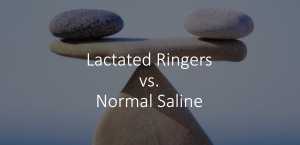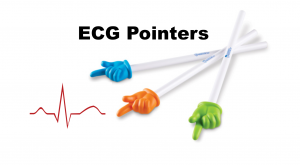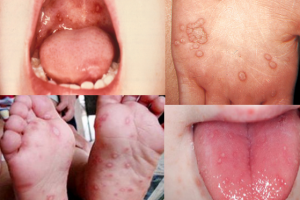Today on the emDOCs cast Brit Long covers SJS/TEN.
Episode 120: Stevens-Johnson Syndrome and Toxic Epidermal Necrolysis
Background:
- SJS and TEN are a continuum of a delayed hypersensitivity reaction affecting the skin and mucous membranes.
- Initially present with nonspecific viral like illness, progresses to rash with mucous membrane involvement, desquamation, end organ injury.
- Based on TBSA: SJS < 10%, TEN > 30%, SJS/TEN overlap 10-30%.
- TBSA calculation includes both detached and undetached areas of erythematous skin.
Epidemiology:
- Uncommon; SJS incidence 9.2 per million adults per year, SJS/TEN overlap incidence 1.6 per million adults per year, TEN incidence 1.9 per million adults per year (lower for pediatric patients).
- Mortality: SJS <5%, TEN 15-50% (pediatrics < 16% for TEN).
Pathophysiology:
- Variety of underlying factors: HLA haplotypes and variations in cytochrome p450 metabolism predispose to SJS/TEN.
- Medications (most common cause): allopurinol, anticonvulsants (phenytoin, phenobarbital, carbamazepine, lamotrigine), antimicrobials (Sulfa meds, quinolones, PCN, HIV meds), steroids, NSAIDs, immunizations (Table 1).
- Higher doses and decreases in medication clearance increase the risk of SJS/TEN.
- ALDEN tool can assist in determining if medication is associated (Table 2).
- Infections: Mycoplasma pneumoniae, Herpes simplex virus (HSV), HIV
- Autoimmune conditions: SLE
- Malignancy: Lymphoma
- Up to 30% have no identifiable risk factor/association.
- Underlying cause triggers cytotoxic T cells and natural killer cells, causes release of cytokines and chemokines. These recruit other immune cells like neutrophils, monocytes, and eosinophils into the skin, the mucosa, and other organs. Causes cellular necrosis with de-epithelialization and end organ injury.
Medications associated with SJS/TEN:
ALDEN Score:



Presentation:
- Period of 3-4 weeks after exposure until symptoms develop (delayed hypersensitivity), but can be 4 days up to 8 weeks.
- Acute and chronic phases.
- Acute: lasts 7-9 days. Marked by viral prodrome, rash, desquamation, organ injury.
- Viral prodrome for 3 days (fevers, chills, myalgia, headache, sore throat), then rash starts on face/thorax that spreads peripherally with desquamation and organ injury.
- Rash is symmetrical and erythematous first, then over 5-7 days it becomes dusky, purpuric, atypical targetoid macules. Followed by blistering and sheet-like desquamation.
- Rash may be painful; severe skin pain may occur prior to rash.
- Mucous membrane is common; may occur prior to rash: oral cavity, conjunctivae, genitals/urethra, nasal cavity, larynx, gastrointestinal tract, and the bronchi.
- Up to 80% have > 2 mucosal surfaces affected.
- Electrolyte derangements, dehydration, organ injury (e.g., renal, hepatic, pulmonary), sepsis, hypothermia, death.
- Chronic phase: disease stops progressing in convalescent stage, then recovery stage.
- Acute: lasts 7-9 days. Marked by viral prodrome, rash, desquamation, organ injury.


ED Evaluation:
- Clinical diagnosis in the ED based on history and exam.
- Consider SJS/TEN in patients with painful mucocutaneous eruption of erythematous or purpuric macules with progressive blistering and mucous membrane involvement.
- History: look for associations and medications.
- Exam:
- First assess ABCs and evaluate for end organ injury and complications (pneumonia, cellulitis, renal injury).
- Evaluate total body surface for rash and mucous membrane involvement.
- Classic exam finding: pseudo-Nikolsky sign (shearing of the epidermis with application of gentle, lateral shearing force an erythematous or purpuric area; no sloughing with normal skin). PV and SSSS have Nikolsky sign (sloughing with pressure over existing lesions, perilesional skin, and areas of normal-appearing skin).
- No mucous membrane significantly reduces likelihood of SJS/TEN.
- Eyes in 60-100% of cases (conjunctivitis, conjunctival and corneal erosions, conjunctival ulcers, pseudomembrane formation, anterior uveitis); perform fluorescein with woods lamp exam.
- GI in 90% (mucosal erosions, pseudo membrane formation, or hemorrhagic crusting of entire tract starting in the lips/mouth).
- ENT: nose in 50%, posterior oropharynx in 30%, esophagus in 55%.
- GU in 70% (urethral stricture, vaginal adenosis, and adhesions).
- Lungs in 10% (bronchial/alveolar erosions).
Labs and imaging:
- Not necessary for diagnosis but recommended for evaluation for end organ injury
- Electrolytes, renal and liver function, CBC, lactic acid, CRP/ESR, coag panel, UA, chest x-ray.
- Anemia, leukopenia, neutropenia, renal or liver injury, elevated LDH common but nonspecific.
- Diagnosis involves biopsy and histopathologic testing of the lesions by dermatology and pathology.
- Other biomarkers available but not helpful in ED setting (Fas ligand, granzyme B, soluble CD40 ligand, granulysin, high mobility group protein B1, RIPK3, galectin 7, CCR-27, and IL-15).
Management:
- Several components: address ABCs, stop underlying cause, fluid resuscitation, symptom control, burn center consultation, evaluating for sepsis, respiratory management, managing skin lesions/wounds, prognostication.
- Stop any potential causative agents; immediate cessation improves survival.
- Resuscitation: patients at risk of fluid loss/hypovolemia.
- Target euvolemia.
- If hypovolemic -> administer fluid boluses and start maintenance crystalloid infusion.
- One study found the overall fluid requirement in 24 hours was 2.2 mL/kg/percent TBSA.
- Place foley to track urine output; goal output 0.5-1 mL/kg/hr.
- If hypotensive despite fluids, start vasopressors.
- Replete electrolytes.
- Treat pain/nausea.
- Burn center consultation; need center with multidisciplinary care (critical care, dermatology, burn surgery, ophthalmology, ENT, pulmonology, gastroenterology, nephrology, urology, gynecology, psychiatry, wound care, and nutrition).
- Sepsis is a leading cause of death due to superimposed infection.
- Cellulitis and pneumonia are major complications.
- Consider sepsis/septic shock if significantly abnormal vital signs/shock present with mucocutaneous eruption suggestive of SJS/TEN.
- If concerned for superimposed infection, start broad-spectrum antibiotics (vancomycin or linezolid with cefepime, piperacillin-tazobactam, meropenem, amikacin, or aztreonam).
- Otherwise, avoid antibiotics. Prophylactic antibiotics not recommended (increases risk of multidrug bacteria and exposing patients to other antibiotic adverse events).
- Respiratory: respiratory compromise may develop.
- If hypoxemic -> bronchial mucosal injury likely (chest x-ray often normal). Start with supplemental oxygen.
- If refractory hypoxia, trouble handling secretions, refractory pain, unable to protect airway -> intubate with larger bore tube if possible. Be prepared with smaller tube (risk of laryngeal edema).
- Follow ARDSnet strategy (TV 6 mL/kg of ideal body weight, plateau pressures < 30 cm H2O).
- Wounds:
- Gently cleanse with sterile water or chlorhexidine, cover with sterile non-adherent dressing.
- Avoid rupturing or debriding blisters.
- Provide preservative-free artificial tears or sterile saline rinses for ocular wounds.
- Systemic therapies are available (cyclosporine, infliximab, IVIG, steroids, plasmapheresis), but limited high quality data supporting their use.
- Prognostication
- Patients are critically ill.
- SCORTEN Score is based on 7 clinical and laboratory criteria (age, heart rate, known malignancy, TBSA, serum BUN, bicarbonate, glucose).

Takeaways:
- SJS/TEN is a continuum of delayed hypersensitivity reaction that causes de-epithelialization of the skin and mucous membranes.
- Most cases are triggered by recent exposure to medications, but may be due to a recent infection, autoimmune disease, or have no apparent trigger.
- Consider SJS/TEN in any patient presenting with a blistering mucocutaneous eruption.
- Clinical diagnosis on your history and exam, but also evaluate for end organ injury and infection.
- Management focuses on identifying the cause, assessing their airway and breathing, fluid resuscitating, treating any superimposed infections with broad spectrum antibiotic therapy, and wound care. Patients ultimately need a burn center with multidisciplinary care.
References/Further Reading:
- van Nispen C, Long B, Koyfman A. High risk and low prevalence diseases: Stevens Johnson syndrome and toxic epidermal necrolysis. Am J Emerg Med. 2024 Jul;81:16-22. doi: 10.1016/j.ajem.2024.04.001.
- Owen CE, Jones JM. Recognition and Management of Severe Cutaneous Adverse Drug Reactions (Including Drug Reaction with Eosinophilia and Systemic Symptoms, Stevens-Johnson Syndrome, and Toxic Epidermal Necrolysis). Med Clin North Am. 2021;105(4):577-597. https://doi.org/1016/j.mcna.2021.04.001.
- Hsu DY, Brieva J, Silverberg NB, Silverberg JI. Morbidity and Mortality of Stevens-Johnson Syndrome and Toxic Epidermal Necrolysis in United States Adults. J Invest Dermatol. 2016;136(7):1387-1397. https://doi.org/1016/j.jid.2016.03.023.
- Frantz R, Huang S, Are A, Motaparthi K. Stevens-Johnson Syndrome and Toxic Epidermal Necrolysis: A Review of Diagnosis and Management. Medicina (Kaunas). 2021;57(9):895. https://doi.org/3390/medicina57090895.
- Saito Y, Abe R. New insights into the diagnosis and management of Stevens-Johnson syndrome and toxic epidermal necrolysis. Curr Opin Allergy
- Wong A, Malvestiti AA, Hafner Mde F. Stevens-Johnson syndrome and toxic epidermal necrolysis: a review. Rev Assoc Med Bras. 2016;62(5):468-73. https://doi.org/1590/1806-9282.62.05.468.
- Hasegawa A, Abe R. Recent advances in managing and understanding Stevens-Johnson syndrome and toxic epidermal necrolysis. F1000Res. 2020;9:F1000 Faculty Rev-612. https://doi.org/12688/f1000research.24748.1.
- Tankunakorn J, Sawatwarakul S, Vachiramon V, Chanprapaph K. Stevens-Johnson Syndrome and Toxic Epidermal Necrolysis-Like Lupus Erythematosus. J Clin Rheumatol. 2019;25(5):224-231. https://doi.org/1097/RHU.0000000000000830.
- Sassolas B, Haddad C, Mockenhaupt M, et al. ALDEN, an algorithm for assessment of drug causality in Stevens-Johnson Syndrome and toxic epidermal necrolysis: comparison with case-control analysis. Clin Pharmacol Ther. 2010;88(1):60-68.
- Kumar R, Das A, Das S. Management of Stevens-Johnson Syndrome-Toxic Epidermal Necrolysis: Looking Beyond Guidelines! Indian J Dermatol. 2018;63(2):117-124. https://doi.org/4103/ijd.IJD_583_17.
- Shiga S, Cartotto R. What are the fluid requirements in toxic epidermal necrolysis? J Burn Care Res. 2010;31(1):100-4. https://doi.org/1097/BCR.0b013e3181cb8cb8.
- McCullough M, Burg M, Lin E, et al. Steven Johnson Syndrome and Toxic Epidermal Necrolysis in a burn unit: A 15-year experience. Burns. 2017;43(1):200-205. https://doi.org/1016/j.burns.2016.07.026.
- Jacobsen A, Olabi B, Langley A, et al. Systemic interventions for treatment of Stevens-Johnson syndrome (SJS), toxic epidermal necrolysis (TEN), and SJS/TEN overlap syndrome. Cochrane Database Syst Rev. 2022;3(3):CD013130.
- Cartotto R, Mayich M, Nickerson D, Gomez M. SCORTEN accurately predicts mortality among toxic epidermal necrolysis patients treated in a burn center. J Burn Care Res. 2008;29(1):141-6. https://doi.org/1097/BCR.0b013e31815f3865.
- Guégan S, Bastuji-Garin S, Poszepczynska-Guigné E, et al. Performance of the SCORTEN during the first five days of hospitalization to predict the prognosis of epidermal necrolysis. J Invest Dermatol. 2006;126(2):272-6. https://doi.org/10.1038/sj.jid.5700068
- Torres-Navarro I, Briz-Redón Á, Botella-Estrada R. Accuracy of SCORTEN to predict the prognosis of Stevens-Johnson syndrome/toxic epidermal necrolysis: a systematic review and meta-analysis. J Eur Acad Dermatol Venereol. 2020;34(9):2066-2077. https://doi.org/10.1111/jdv.16137.
- Koh HK, Fook-Chong S, Lee HY. Assessment and Comparison of Performance of ABCD-10 and SCORTEN in Prognostication of Epidermal Necrolysis. JAMA Dermatol. 2020;156(12):1294-1299.






